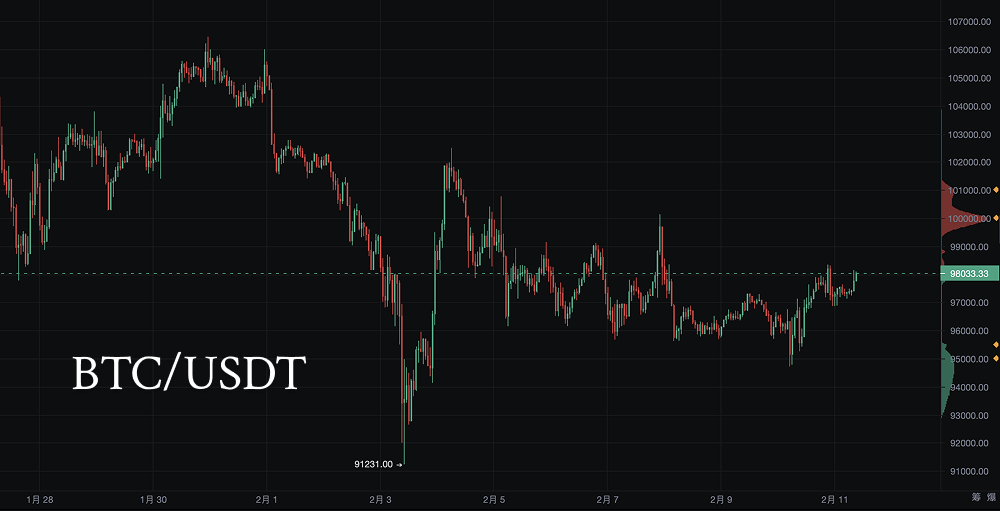Recent market dynamics clearly illustrate the complex and subtle relationship between gold and Bitcoin. Both are often viewed as potential safe-haven assets, but their performances diverge significantly under global economic and policy changes. Driven by trade tensions, geopolitical turmoil, and inflation concerns, gold prices have soared, while Bitcoin faces significant selling pressure, appearing to stumble amid increasing global uncertainty.
The Resurgence of Gold: A Victory for Traditional Safe-Haven Attributes
Gold prices have recently surged, reaching a peak of $2900 per ounce and approaching the $3000 mark. This rally is primarily driven by investors' urgent demand for traditional safe-haven assets in the face of trade frictions (such as Trump's threats of tariffs on steel and aluminum imports). Additionally, gold's appeal as a time-tested store of value during economic turmoil has further strengthened.
Geopolitical tensions, such as Trump's comments about the U.S. potentially occupying Gaza, have also stimulated demand for gold. Such events reinforce gold's status as a safe-haven asset, attracting investors seeking to preserve their assets.
Market analysts have differing views on the future trajectory of gold. Some believe that, driven by inflation trends and supply shortages, gold prices could break through the $3000 barrier, with some analysts boldly predicting a potential surge to $4000 within the next 12 months.

Bitcoin's Struggle: The Fate of a Risk Asset?
In stark contrast to gold's strong performance, Bitcoin has recently faced significant sell-offs, with prices pressured downward under similar uncertainty factors. Bitcoin fell 1% within 24 hours, Ethereum dropped 1.8%, and other cryptocurrencies also faced varying degrees of downward pressure.
This round of correction is primarily influenced by inflation pressures triggered by tariffs, with the market concerned that the Federal Reserve may accelerate interest rate hikes as a result. Rate hikes are typically unfavorable for high-risk assets like Bitcoin.
Despite the overall market downturn, Bitcoin ETFs (exchange-traded funds) still attract some investor interest. However, position data indicates that the trend in the Bitcoin market is weakening, with selling pressure on exchanges reaching its highest level since the collapse of the Three Arrows Capital (3AC) crypto hedge fund.

The Interaction Between Gold and Bitcoin: A Zero-Sum Game?
Although Bitcoin enthusiasts have long believed that it will eventually replace gold as a new store of value, reality seems otherwise. In times of increasing market uncertainty, gold remains the more favored safe-haven choice among investors.
The Bitcoin/gold ratio has significantly decreased, indicating that during economic turmoil, investors trust gold more than Bitcoin.
Some analysts point out that Bitcoin's movements are more closely correlated with the stock market (especially tech stocks), suggesting that the current market is more inclined to view it as a risk asset rather than a safe-haven asset. However, there are also views that, over time, Bitcoin's intrinsic properties may gradually align it more closely with value-storing assets.

The Impact of Macroeconomics and Policy: Under Currents
Strengthening Dollar: Due to tariff policies and the Federal Reserve's hawkish stance, the dollar continues to appreciate, further diminishing Bitcoin's appeal as a safe haven.
Trump's Tariff Policy: Tariff measures have exacerbated trade tensions and heightened inflation risks. This has driven the dollar to new highs while boosting gold prices, but negatively impacting the cryptocurrency market.
Central Bank Policies and Interest Rate Decisions: The Federal Reserve may further raise interest rates in the future, which the market is closely monitoring. The direction of interest rates will directly affect investors' preferences for gold and Bitcoin.

The Role of Artificial Intelligence (AI) in the Market: A New Variable
AI trading algorithms are actively responding to market changes. Data shows that AI trading volume increases as gold prices rise, indicating that AI is adjusting trading strategies based on market signals.
Additionally, the prices of AI-related tokens have seen some increases, which may reflect market optimism regarding AI technology and its investment prospects.
Conclusion: Different Paths to the Same Destination?
Recent market fluctuations highlight the complex and dynamic relationship between gold and Bitcoin, which is also profoundly influenced by macroeconomic and policy decisions. Amid increasing global geopolitical and economic uncertainty, gold continues to solidify its position as a safe-haven asset, while Bitcoin faces significant selling pressure. The market is highly sensitive to trade tensions, inflation levels, and interest rate decisions, with investors closely monitoring these factors to navigate a complex and unpredictable economic environment.
Although gold and Bitcoin exhibit divergent short-term performances, they both reflect investors' demand for safe havens during uncertain times. In the long run, if Bitcoin can shed its label as a high-risk asset and demonstrate stronger value-storing properties, it may still carve out a place in the realm of safe-haven assets.
However, in the foreseeable future, gold may remain the preferred safe-haven paradise for investors during turbulent times.
Disclaimer: The above content does not constitute investment advice.
If you have any questions, you can contact us through the following official channels:
AiCoin Official Website: www.aicoin.com
Telegram: t.me/aicoincn
Twitter: x.com/AiCoinzh
Email: support@aicoin.com
Group Chat: Customer Service Yingying、Customer Service KK
免责声明:本文章仅代表作者个人观点,不代表本平台的立场和观点。本文章仅供信息分享,不构成对任何人的任何投资建议。用户与作者之间的任何争议,与本平台无关。如网页中刊载的文章或图片涉及侵权,请提供相关的权利证明和身份证明发送邮件到support@aicoin.com,本平台相关工作人员将会进行核查。




